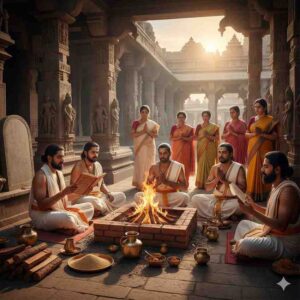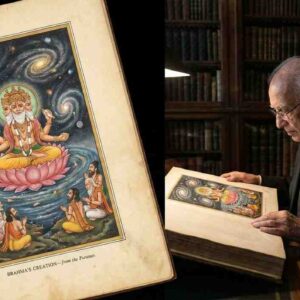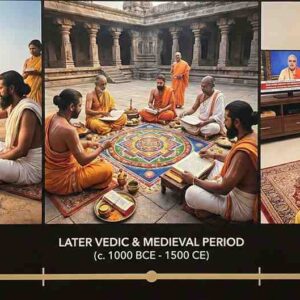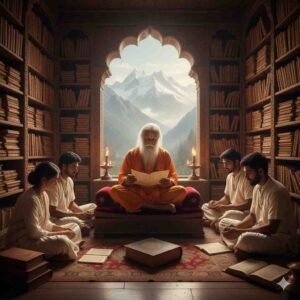TheVedasandShastrasare two integral pillars of Indian spiritual and intellectual tradition. While the Vedas are regarded as the ultimate source of divine knowledge and universal truths, the Shastras interpret and adapt these teachings for practical application in everyday life. Together, they shape the quest for knowledge, but do they offer different paths to understanding, or are they complementary in their purpose?
This article explores the relationship between these ancient texts, examining their roles in guiding individuals on their journey toward truth, wisdom, and ethical living.
The Vedas: The Eternal Source of Knowledge
TheVedas—Rigveda,Yajurveda,Samaveda, andAtharvaveda—are consideredShruti(that which is heard), divinely revealed and eternal. They provide the foundation for spiritual, metaphysical, and cosmic understanding.
Key Characteristics of the Vedas
- Cosmic Truths: The Vedas explore universal principles, such as Rita (cosmic order), Brahman (ultimate reality), and Atman (soul).
- Rituals and Worship: Detailed instructions for yajnas (sacrifices) and prayers aim to maintain harmony with the cosmos.
- Metaphysical Inquiry: The latter portions of the Vedas, particularly the Upanishads, focus on philosophical questions about existence and liberation (Moksha).
- Timeless Authority: The Vedas are considered infallible and universal, transcending temporal and cultural contexts.
The Vedas serve as a guide to understanding the divine and aligning human actions with the cosmic order.
The Shastras: The Practical Interpreters
TheShastras, classified asSmriti(that which is remembered), interpret and contextualize the eternal truths of the Vedas. Texts like theDharma Shastras,Arthashastra, andNatyashastratranslate Vedic principles into actionable frameworks for governance, ethics, and culture.
Key Characteristics of the Shastras
- Ethical and Social Frameworks: The Manusmriti outlines Dharma (righteous duties) for individuals and society.
- Practical Application: Texts like the Arthashastra provide guidelines for governance and statecraft.
- Cultural Guidance: The Natyashastra extends Vedic ideas into the performing arts, emphasizing cosmic rhythm and emotional expression.
- Evolving Wisdom: Unlike the eternal Vedas, the Shastras evolve with time, adapting to societal changes and challenges.
The Shastras make the abstract principles of the Vedas accessible and applicable in real-world contexts.
Different Paths or Complementary Roles?
1. Theoretical vs. Practical Knowledge
- Vedas: Offer theoretical knowledge of the cosmos, spirituality, and metaphysics.
- Shastras: Focus on practical wisdom for living a harmonious and ethical life.
2. Eternal vs. Evolving
- Vedas: Timeless and universal, providing truths that transcend temporal boundaries.
- Shastras: Dynamic and adaptive, interpreting Vedic teachings to suit changing societal needs.
3. Cosmic Order vs. Social Order
- Vedas: Emphasize cosmic principles like Rita and Brahman.
- Shastras: Translate these principles into social frameworks like Dharma and governance.
4. Complementary Paths to Knowledge
While the Vedas and Shastras appear to offer different paths, they are inherently complementary. The Vedas provide thewhy(universal truths), and the Shastras offer thehow(practical implementation).
Modern Relevance of the Vedas and Shastras
In today’s world, the interplay between the Vedas and Shastras continues to inspire spiritual and intellectual growth:
- Ethical Living: The Shastras’ interpretation of Dharma provides timeless moral guidelines.
- Mindfulness and Meditation: Vedic teachings on Atman and Brahman influence modern practices like yoga and mindfulness.
- Governance and Policy: The Arthashastra offers insights into governance, economics, and leadership that remain relevant today.
- Cultural Preservation: The Natyashastra’s guidance on arts and aesthetics ensures the continuity of Indian cultural heritage.
Conclusion: Two Paths, One Destination
The Vedas and Shastras, though distinct in their approach, share a unified goal: guiding individuals toward a deeper understanding of life, ethics, and the divine. The Vedas illuminate eternal truths, while the Shastras bring these truths to life in practical ways.
Together, they form a holistic framework that balances spiritual inquiry with ethical action, offering timeless wisdom for navigating the complexities of existence. Whether as complementary paths or distinct approaches, the Vedas and Shastras remain integral to humanity’s quest for knowledge.












